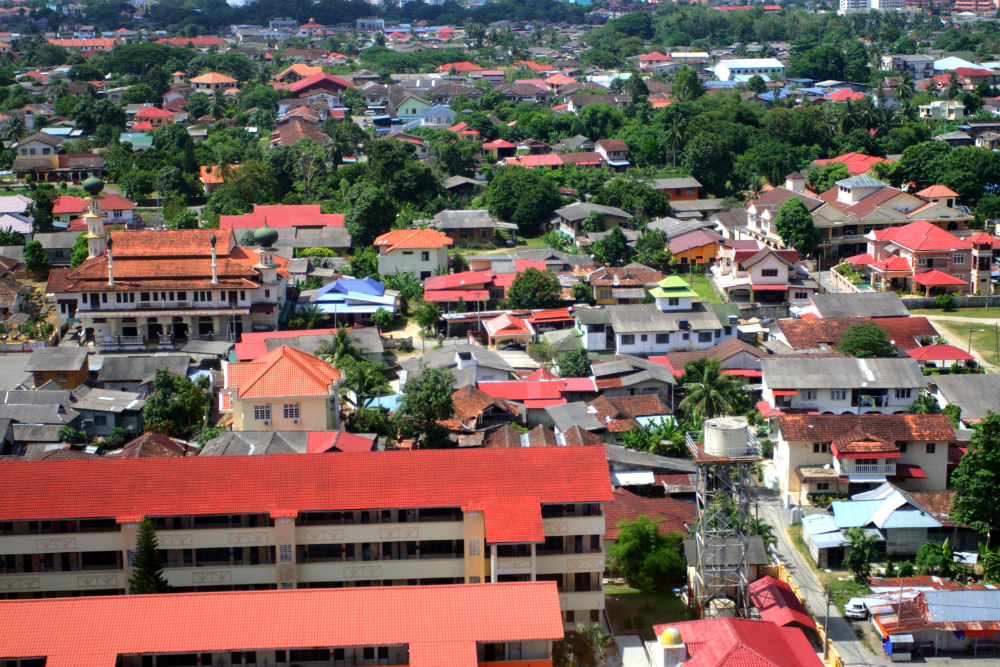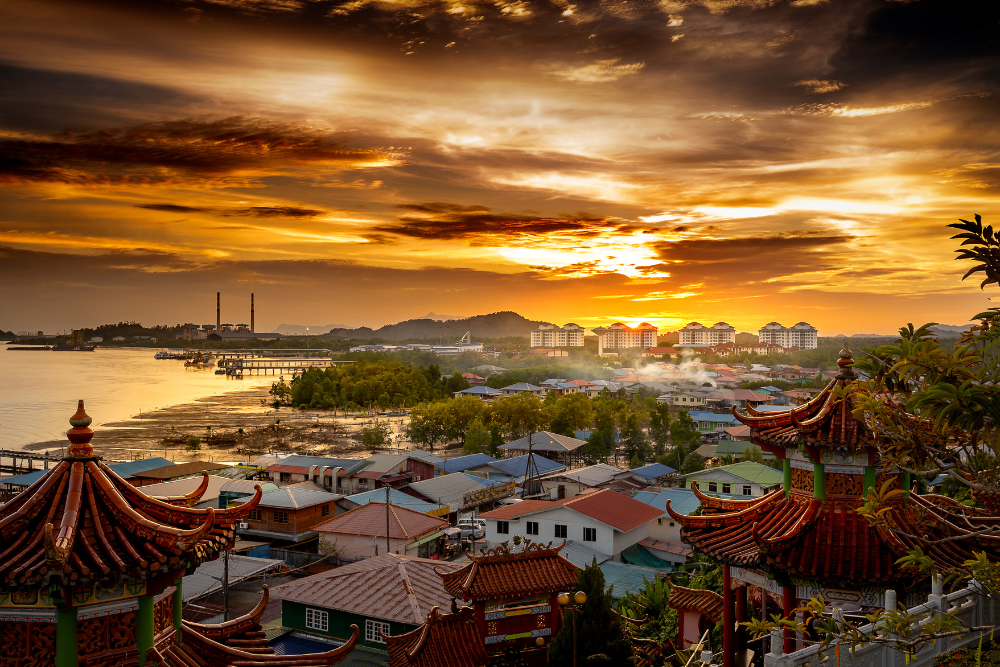Malaysia is a country rich in cultural diversity, and its heritage towns are living testaments to the nation’s colonial past, traditional craftsmanship, and unique blend of Malay, Chinese, Indian, and European influences. From the bustling streets of Penang to the quaint alleys of Melaka, these towns offer a fascinating look at the evolution of architectural styles in Malaysia. In this guide, we explore the architectural gems of Malaysia’s heritage towns, each one a testament to a fascinating history shaped by centuries of trade, colonial rule, and local traditions.
1. George Town, Penang: A Fusion of Cultures
Why it’s unique:
George Town, the capital city of Penang, is a UNESCO World Heritage Site that showcases a unique blend of colonial, Chinese, Malay, and Indian influences. The town’s architecture is a mosaic of styles, including classic shophouses, grand colonial mansions, and ornate temples. Its heritage areas feature narrow streets lined with old buildings that reflect the influence of foreign powers and the town’s significance as a trading hub.
Architectural Highlights:
- Shophouses: Penang’s iconic shophouses are perhaps the most recognizable aspect of its architectural landscape. These narrow, long buildings were built in the 19th and early 20th centuries and have a distinctive style that combines Chinese, Malay, and European elements. The ground floor was typically used for business, while the upper floors served as residential space.
- Chinese Clan Halls: George Town boasts some of Malaysia’s most elaborate clan halls, such as the Khoo Kongsi, which feature intricate wooden carvings, tiled roofs, and decorative motifs that reflect the Chinese heritage of the city.
- Colonial Mansions: The town also has an array of colonial-era mansions, such as Cheong Fatt Tze Mansion (also known as the Blue Mansion), a stunning example of traditional Chinese architecture fused with British colonial elements.
- Religious Buildings: George Town is home to temples, mosques, and churches, each showcasing distinct architectural styles. The Khoo Kongsi and the Sri Mahamariamman Temple are notable for their intricate designs, while St. George’s Church is a fine example of British colonial architecture.
Best Way to Explore:
Walking through George Town is the best way to experience its architectural charm. The city’s vibrant street art scene further enhances the historic backdrop, with murals and installations popping up around every corner.
2. Melaka: A Tapestry of Colonial Influence
Why it’s unique:
As one of Malaysia’s most historically significant towns, Melaka (Malacca) is a UNESCO World Heritage Site known for its well-preserved buildings dating back to the 15th century. A melting pot of Portuguese, Dutch, and British influences, Melaka’s architecture tells the story of its time as a major port for trade between East and West. The city’s blend of colonial and traditional Malay architecture gives it a unique character that is distinct from other Malaysian heritage towns.
Architectural Highlights:
- Stadthuys (Dutch Square): One of the most recognizable landmarks in Melaka, the Stadthuys is an iconic red Dutch colonial building that was once the administrative center of the Dutch East India Company. It’s a great example of Dutch influence on the town’s architecture.
- A Famosa: The remains of this Portuguese fort, including the Porta de Santiago, are among the oldest European architectural structures in Southeast Asia. This fortification marks the Portuguese colonization of Melaka in the early 1500s.
- Cheng Hoon Teng Temple: This 17th-century Chinese temple is the oldest functioning temple in Malaysia. Its elaborate wood and stone carvings, combined with traditional Chinese architecture, provide a glimpse into Melaka’s early Chinese heritage.
- Jonker Street: This street is lined with traditional Straits Chinese Peranakan houses, which blend Chinese and Malay architectural styles. The brightly painted facades and intricate wooden carvings showcase the artistry of the Peranakan culture.
Best Way to Explore:
Taking a leisurely walk around Jonker Street and the historic core of Melaka will give you the opportunity to admire its well-preserved architecture. Don’t miss the opportunity to visit the many museums housed in colonial-era buildings, where you can learn more about the history of the town.
3. Ipoh: The Art Deco Charm
Why it’s unique:
Ipoh, the capital city of Perak, has been known for its well-preserved colonial architecture. During the tin mining boom in the late 19th and early 20th centuries, Ipoh grew rapidly and became a center for British administration and wealth. As a result, many of the town’s architectural landmarks are a reflection of British colonialism, as well as the influence of Art Deco design, which became popular in the early 20th century.
Architectural Highlights:
- The Ipoh Railway Station: Often referred to as the “Taj Mahal of Ipoh,” this colonial-era building combines Moorish and British influences. The station’s grand arches and high ceilings showcase the elegant simplicity of colonial architecture.
- Art Deco Buildings: Ipoh is home to several Art Deco-style buildings, including the Old Town Hall and the Majestic Theatre, which feature geometric shapes, bold lines, and intricate decorative elements. These buildings serve as great examples of the early 20th-century aesthetic.
- Kinta Riverfront: The area along the Kinta River has seen a resurgence in recent years, with old colonial shophouses being preserved and repurposed. Walking along the riverfront, you’ll find charming cafes and boutique shops housed in buildings that date back to the tin mining era.
Best Way to Explore:
A visit to Old Town Ipoh is the best way to take in the town’s colonial architecture. Be sure to stop by one of the old kopitiams (coffee shops) for a taste of Ipoh’s famous white coffee.
4. Taiping: The Colonial Legacy
Why it’s unique:
Taiping, once the capital of Perak, has a rich history as the center of Malaysia’s tin mining industry. Known for its tranquil atmosphere and colonial architecture, Taiping retains many heritage buildings that highlight British influence in Malaysia. It’s a less touristy destination but offers a wealth of historical architecture to explore.
Architectural Highlights:
- Taiping Lake Gardens: This former colonial plantation was transformed into one of Malaysia’s oldest public parks. The lake, along with its iconic bridges, pavilion, and colonial-style buildings, is a testament to the British vision of leisure and public space.
- The Old Clock Tower: Built in 1881, this clock tower is a prominent feature of the town’s colonial landscape, with its Victorian-style design providing a contrast to the traditional Malay architecture nearby.
- Maxwell Hill (Bukit Larut): A hill station that was developed during British colonial rule, Maxwell Hill features charming colonial-era bungalows and offers a glimpse into the lifestyle of the British officers stationed in the area.
Best Way to Explore:
Take a leisurely stroll through Taiping Lake Gardens or visit some of the colonial-era buildings along Jalan Station for a glimpse of the town’s history.
5. Kota Bharu: Traditional Malay Architecture
Why it’s unique:
Kota Bharu, the capital of Kelantan, is a center for traditional Malay culture and architecture. Unlike the colonial towns in other parts of Malaysia, Kota Bharu showcases authentic Malay heritage, with buildings reflecting the influence of Islamic art and local craftsmanship. The town’s architecture is known for its intricate woodwork, brightly colored roof tiles, and ornate carvings.
Architectural Highlights:
- Istana Jahar: This royal palace, built in the late 19th century, is a fine example of Kelantanese architecture, with its intricate wooden carvings and traditional Malay design.
- Siti Khadijah Market: This bustling market, named after the Prophet Muhammad’s first wife, features a distinctive local architectural style with colorful tiled roofs and open-air stalls.
- Masjid Muhammadi: A beautiful example of traditional Malay mosque architecture, this mosque features a large wooden structure with a tiered roof and intricate carvings.
Best Way to Explore:
Explore the traditional wooden houses and markets in the town center to fully appreciate the local Malay architectural style. Don’t miss the chance to experience the rich culture through the town’s handicrafts and traditional performances.
Conclusion
Malaysia’s heritage towns are a testament to the diverse cultural influences that have shaped the country over centuries. From the colonial elegance of George Town and Melaka to the traditional Malay craftsmanship found in Kota Bharu, these towns offer a captivating journey through history, architecture, and culture. Whether you’re a lover of colonial buildings, Chinese clan halls, or traditional Malay houses, Malaysia’s heritage towns will leave you with a deeper understanding of the nation’s past and a lasting appreciation for its architectural diversity.












